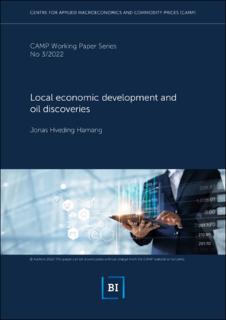| dc.contributor.author | Hamang, Jonas Hveding | |
| dc.date.accessioned | 2022-09-20T07:50:14Z | |
| dc.date.available | 2022-09-20T07:50:14Z | |
| dc.date.issued | 2022-09-15 | |
| dc.identifier.issn | 1892-2198 | |
| dc.identifier.uri | https://hdl.handle.net/11250/3019026 | |
| dc.description.abstract | In this paper I use data on the location of all historic petroleum discoveries onshore to establish a new stylized fact: Economically developed areas are significantly more likely (about five percentage points) to contain an oil discovery, compared to undeveloped areas. This result is robust to accounting for reverse causality, confounding geology and observed or unobserved country characteristics. By implication, there are large underexplored oil and gas deposits in currently undeveloped areas. I calculate these deposits to be approximately 600 billion barrels of oil — amounting to about 50% of the globe’s currently known onshore endowment — and to be mainly located outside of Europe and North America. Exploring alternative mechanisms, I find that infrastructure access may explain the documented discovery differential. | en_US |
| dc.language.iso | eng | en_US |
| dc.relation.ispartofseries | CAMP Working Paper Series;03/2022 | |
| dc.title | Local economic development and oil discoveries | en_US |
| dc.type | Working paper | en_US |
| dc.source.pagenumber | 38 | en_US |
